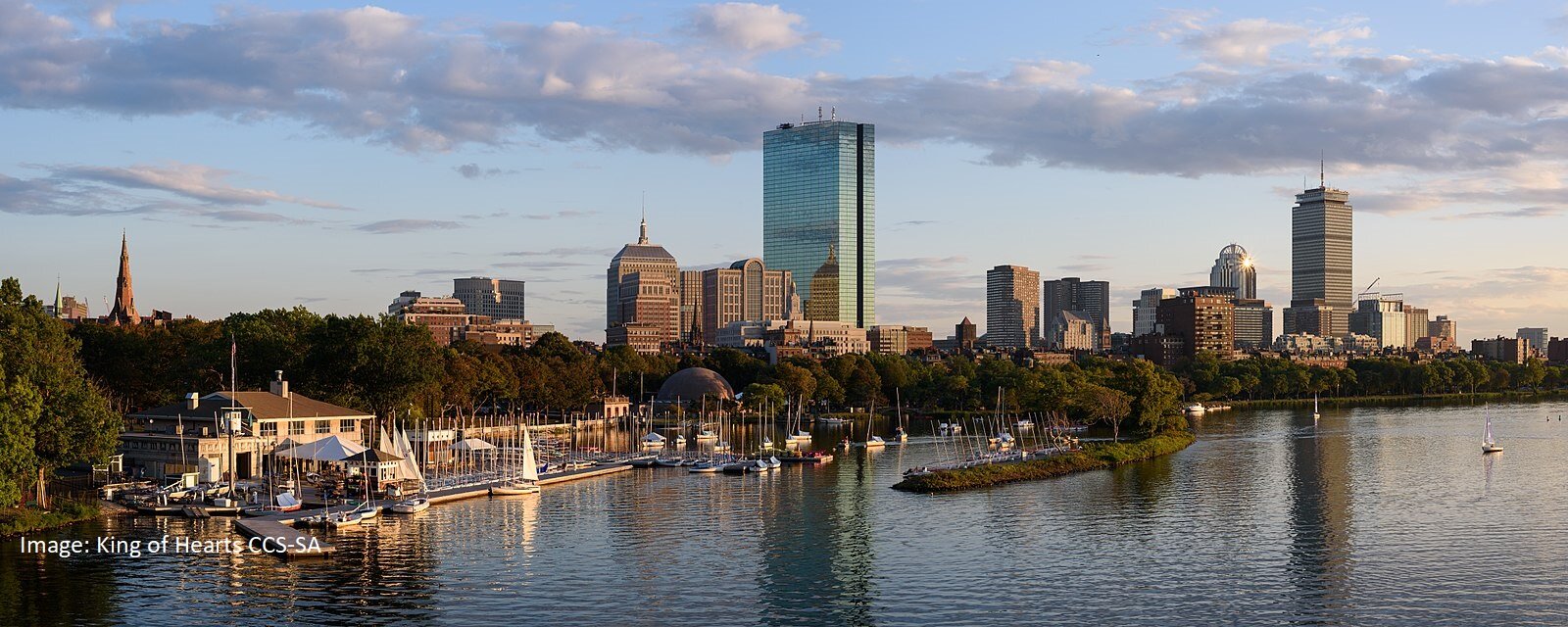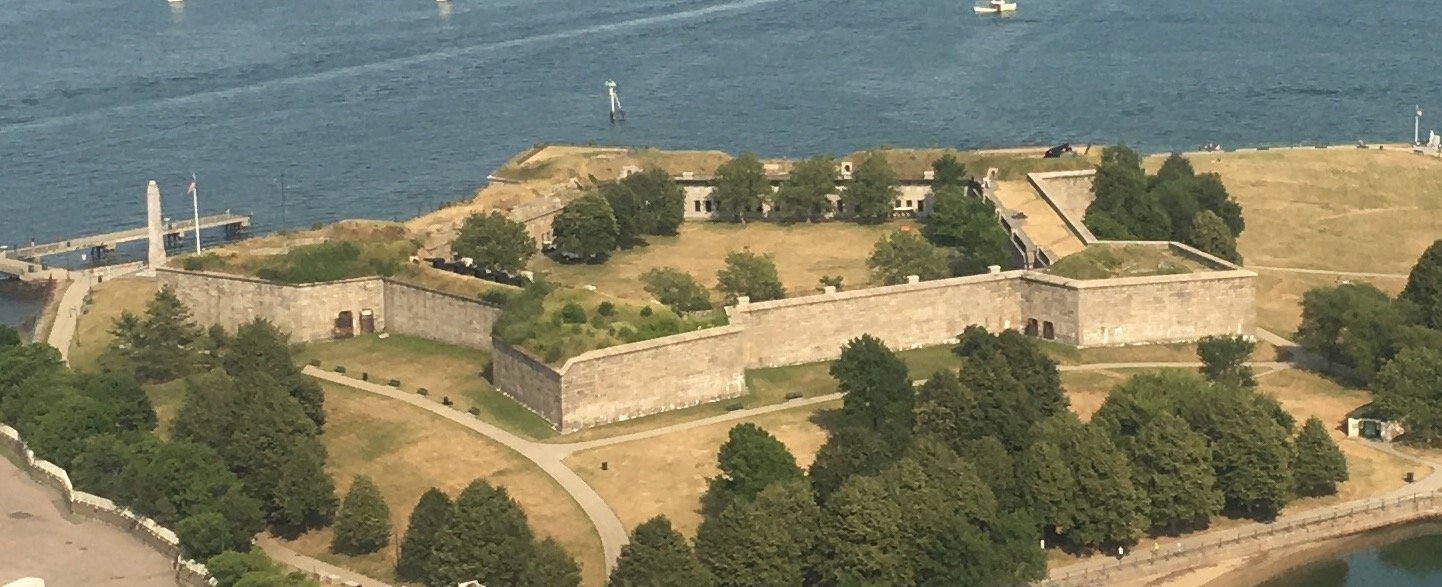
Boston area battle-sites of the Revolution
Boston was the largest town in the Thirteen Colonies until Philadelphia outgrew it in the mid-18th century. Boston's oceanfront location made it a lively port, and the city primarily engaged in shipping and fishing during its colonial days. Many of the crucial events of the American Revolution occurred in or near Boston. With economic growth stagnated, and Boston's penchant for mob action along with the colonists' growing lack of faith in either Britain or its Parliament, a revolutionary spirit in the city was fostered. Today you can still visit many battle sites and structures related to battles for American Independence in and around Boston.
There are several Boston and Massachusetts annual events related to battles of the American Revolution that you may want to include in your visit plans:
Evacuation Day (observed March 17 weekday, or following Monday)
Evacuation Day is Suffolk County (Boston) holiday in Massachusetts, marked with celebrations at Dorchester Heights.
March 17 is also St. Patrick’s day, celebrated with a parade through South Boston and other festivities.Patriot’s Day (observed third Monday of April)
Patriot’s Day commemorates the early battles in the American Revolutionary War in Lexington, Concord, and Menotomy. Celebrations include a parade, presentations, and reenactments in Concord and nearby Minuteman National Park.
Patriot’s day is also when the Boston Marathon is run from Hopkington to Boston.Bunker Hill Day (observed June 17)
Bunker Hill Day commemorates a significant win by the colonial forces over the British troops at the Battle of Bunker Hill during the Siege of Boston. Celebrations occur at the Bunker Hill Monument in Charlestown.
Faneuil Hall
The Great Hall, a meeting hall built above the central Faneuil Hall Marketplace served as location for town meetings after its restoration from fire in 1763. Measures such as the Parliamentary Acts, The Sugar Act of 1764, and the Restraining Acts of 1775, were debated and protested here.
Image: ctj71081 CCA-SA
Boston Massacre
On March 5, 1770, an unruly group of colonists taunted British soldiers by throwing snowballs and rocks. Firing upon the crowd, the British killed five colonists including Crispus Attucks. Today, beneath the Old State House balcony, a circle of granite paving stones mark the approximate site of the Boston Massacre. An additional Boston Massacre Monument was placed in the Boston Common.
Image: Dion Hinchcliffe CCA-SA
Boston Tea Party
On 16 December 1773, members of the Sons of Liberty rallied at the Old South Meeting House to protest the Tea Act of 1773, and the Townshend Act, which enabled the British East India Company to sell tea to the colonists at a financial advantage. The protestors boarded the ships and dumped 92,000 pounds of tea overboard into Boston Harbor. Today you can view a replica ship at the Boston Tea Party Ships & Museum, tour the museum, and participate in a reenactment of the event.
Image: Springfield Museums PD
Old Powder House
On 1 September 1774, British General Thomas Gage ordered his soldiers to remove gunpowder from the magazine at the Old Powder House in Somerville, MA (the oldest stone building in Massachusetts). This action, and rumors that blood had been shed, triggered the Powder Alarm. Word spread through the countryside to Connecticut and beyond, and American Patriots began streaming toward Boston and Cambridge, fearing that war was at hand. Mob action forced Loyalists and some government officials to flee to the protection of the British Army.
Image: Matthew Miller CCA-SA
Battles of Lexington & Concord
On the evening of April 18, 1775, Paul Revere, Samuel Prescott, Israel Bissell, William Dawes, and Sybil Ludington, were signaled that the British were marching to Lexington and Concord by sea across the Charles River in an effort to capture supplies in Concord, and so began their warning ride. Near daybreak the first shots were exchanged in Lexington, and the British continued to Concord. British troops were met by militiamen at the North Bridge, shots were exchanged, and they fell back to their main forces. After concluding their search, the British marched back to Charlestown under fire. Once they reached Charlestown, militias blockaded the land access and initiated the Siege of Boston.
At Minute Man National Historical Park, Patriots’ Day, the third Monday of April, is celebrated with a parade, programs, and reenactments of the first battle.
Image: Jay Sullivan CCA-SA
Battle of Bunker Hill
The Colonists, having learned of a British plan to fortify the Charlestown peninsula, decided to act first, and fortify it in an attempt to cause the British to leave Boston. On 16 June 1775, under the leadership of General Putnam and Colonel Prescott, the Colonists snuck out onto the Charlestown Peninsula, and erected modest fortifications. The next morning, the British set out to reclaim the peninsula. The colonists repelled two attacks, but were forced to retreat on the third British advance. Although the British won, they suffered significant casualties, and were discouraged from future frontal attacks.
Image: Chensiyuan CCA-SA
Roxbury High Fort
The Roxbury High Fort site sits on Beech Glen Street at Fort Avenue, and once contained earthwork fortifications of the Continental Army during the Siege of Boston during the American Revolutionary War. At that time Roxbury was an independent town connected to Boston by a narrow neck of land. The hill offered a great vantage of the entire area. Today the Cochituate Standpipe sits atop Fort Hill, and a commemorative plaque has been placed within by the Sons of the American Revolution.
Image: Brian Corr CCA-SA
Ft. Washington Batteries
In November 1775, George Washington ordered soldiers of the Continental Army to build two half-moon batteries at what is now Fort Washington, also known as Fort Washington Park, at 95 Waverly Street in Cambridge, Massachusetts. It is the oldest surviving fortification from the American Revolutionary War and the only surviving fortification from the Siege of Boston. It features three 18-pound cannon relocated from Ft. Winthrop.
Image: Daderot PD
Battle of Dorchester Heights
After supporting armaments were transported from Ticonderoga to Boston by Col. Henry Knox, Dorchester Heights was fortified by General George Washington on 4-5 March 1776. This advantage compelled the British to withdraw from Boston 17 March 1776, ending the Siege of Boston. A monument was erected on the site in 1902, located in what is now Thomas Park in South Boston, near 95 G St.
Image: Daderot PD
Castle William / Ft. Adams
In the years leading up to the American Revolution, Castle William became a refuge for British officials and soldiers during periods of unrest in Boston. As the American Revolution erupted in 1775, American forces quickly commenced the Siege of Boston and British forces made Castle William their primary stronghold. After the Continental Army placed fortifications at Dorchester Heights, Castle William was threatened and the British evacuated Boston for Nova Scotia 17 March 1776. Today the site is referred to as Castle Island, and is a State Park.
Image: victorgrigas CCA-SA
Cambridge Common Cannon
Throughout the Boston Campaign, the Cambridge Common was used by the Continental Army as a place for drill and encampment. The British abandoned Castle William 17 March 1776, leaving behind armaments including these cannon, which were relocated to Cambridge Common. They are dedicated to Brigadier General Tadeusz Kościuszko, Major General and Boston native Henry Knox, as well as Commander-in-Chief of the Continental Army General George Washington.
Image: Daderot PD
USS Constitution
The post-Revolution naval vessel USS Constitution, also known as Old Ironsides, is a three-masted wooden-hulled heavy frigate of the United States Navy. She is the world's oldest ship still afloat, and was launched in 1797, one of six original frigates authorized for construction by the Naval Act of 1794. These frigates were designed to be larger and more heavily armed than standard frigates of the period. She was built at Edmund Hartt's shipyard in the North End of Boston, Massachusetts. Her first duties were to provide protection for American merchant shipping during the Quasi-War with France 1798-1801, the First Barbary War 1801-1805, and the War of 1812.
Image: Matthew R. Fairchild PD











